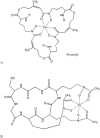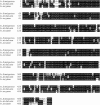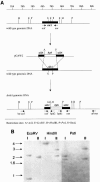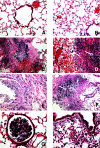The Aspergillus fumigatus siderophore biosynthetic gene sidA, encoding L-ornithine N5-oxygenase, is required for virulence
- PMID: 16113265
- PMCID: PMC1231119
- DOI: 10.1128/IAI.73.9.5493-5503.2005
The Aspergillus fumigatus siderophore biosynthetic gene sidA, encoding L-ornithine N5-oxygenase, is required for virulence
Abstract
Aspergillus fumigatus is the leading cause of invasive mold infection and is a serious problem in immunocompromised populations worldwide. We have previously shown that survival of A. fumigatus in serum may be related to secretion of siderophores. In this study, we identified and characterized the sidA gene of A. fumigatus, which encodes l-ornithine N(5)-oxygenase, the first committed step in hydroxamate siderophore biosynthesis. A. fumigatus sidA codes for a protein of 501 amino acids with significant homology to other fungal l-ornithine N(5)-oxygenases. A stable DeltasidA strain was created by deletion of A. fumigatus sidA. This strain was unable to synthesize the siderophores N',N",N'''-triacetylfusarinine C (TAF) and ferricrocin. Growth of the DeltasidA strain was the same as that of the wild type in rich media; however, the DeltasidA strain was unable to grow in low-iron defined media or media containing 10% human serum unless supplemented with TAF or ferricrocin. No significant differences in ferric reduction activities were observed between the parental strain and the DeltasidA strain, indicating that blocking siderophore secretion did not result in upregulation of this pathway. Unlike the parental strain, the DeltasidA strain was unable to remove iron from human transferrin. A rescued strain (DeltasidA + sidA) was constructed; it produced siderophores and had the same growth as the wild type on iron-limited media. Unlike the wild-type and rescued strains, the DeltasidA strain was avirulent in a mouse model of invasive aspergillosis, indicating that sidA is necessary for A. fumigatus virulence.
Figures







Similar articles
-
The siderophore system is essential for viability of Aspergillus nidulans: functional analysis of two genes encoding l-ornithine N 5-monooxygenase (sidA) and a non-ribosomal peptide synthetase (sidC).Mol Microbiol. 2003 Jul;49(2):359-75. doi: 10.1046/j.1365-2958.2003.03586.x. Mol Microbiol. 2003. PMID: 12828635
-
Effects of the Aspergillus fumigatus siderophore systems on the regulation of macrophage immune effector pathways and iron homeostasis.Immunobiology. 2008;213(9-10):767-78. doi: 10.1016/j.imbio.2008.07.010. Epub 2008 Sep 7. Immunobiology. 2008. PMID: 18926292
-
Site-specific rate constants for iron acquisition from transferrin by the Aspergillus fumigatus siderophores N',N'',N'''-triacetylfusarinine C and ferricrocin.J Biol Inorg Chem. 2005 May;10(3):211-20. doi: 10.1007/s00775-005-0630-z. Epub 2005 Mar 16. J Biol Inorg Chem. 2005. PMID: 15770504
-
Intracellular and extracellular growth of Aspergillus fumigatus.Med Mycol. 2005 May;43 Suppl 1:S27-30. doi: 10.1080/13693780400029247. Med Mycol. 2005. PMID: 16110789 Review.
-
Iron homeostasis--Achilles' heel of Aspergillus fumigatus?Curr Opin Microbiol. 2011 Aug;14(4):400-5. doi: 10.1016/j.mib.2011.06.002. Epub 2011 Jul 1. Curr Opin Microbiol. 2011. PMID: 21724450 Free PMC article. Review.
Cited by
-
Contribution of Autophagy to Cellular Iron Homeostasis and Stress Adaptation in Alternaria alternata.Int J Mol Sci. 2024 Jan 17;25(2):1123. doi: 10.3390/ijms25021123. Int J Mol Sci. 2024. PMID: 38256200 Free PMC article.
-
Spore Germination Requires Ferrichrome Biosynthesis and the Siderophore Transporter Str1 in Schizosaccharomyces pombe.Genetics. 2019 Mar;211(3):893-911. doi: 10.1534/genetics.118.301843. Epub 2019 Jan 15. Genetics. 2019. PMID: 30647069 Free PMC article.
-
Transcriptomic and proteomic host response to Aspergillus fumigatus conidia in an air-liquid interface model of human bronchial epithelium.PLoS One. 2018 Dec 27;13(12):e0209652. doi: 10.1371/journal.pone.0209652. eCollection 2018. PLoS One. 2018. PMID: 30589860 Free PMC article.
-
Characterizing the Pathogenic, Genomic, and Chemical Traits of Aspergillus fischeri, a Close Relative of the Major Human Fungal Pathogen Aspergillus fumigatus.mSphere. 2019 Feb 20;4(1):e00018-19. doi: 10.1128/mSphere.00018-19. mSphere. 2019. PMID: 30787113 Free PMC article.
-
Role of Ser-257 in the sliding mechanism of NADP(H) in the reaction catalyzed by the Aspergillus fumigatus flavin-dependent ornithine N5-monooxygenase SidA.J Biol Chem. 2013 Nov 8;288(45):32440-32448. doi: 10.1074/jbc.M113.487181. Epub 2013 Sep 26. J Biol Chem. 2013. PMID: 24072704 Free PMC article.
References
-
- Abe, F., H. Inaba, T. Katoh, and M. Hotchi. 1990. Effects of iron and desferrioxamine on Rhizopus infection. Mycopathologia 110:87-91. - PubMed
-
- Anderson, M. J. 2004, posting date. A proposal for the naming of genes in Aspergillus species. [Online.] http://www.aspergillus.man.ac.uk/indexhome.htm?homepagenew/mainindex.htm....
-
- Bodey, G., B. Bueltmann, W. Duguid, D. Gibbs, H. Hanak, M. Hotchi, G. Mall, P. Martino, F. Meunier, S. Milliken, et al. 1992. Fungal infections in cancer patients: an international autopsy survey. Eur. J. Clin. Microbiol. Infect. Dis. 11:99-109. - PubMed
-
- Brown, J. S., A. Aufauvre-Brown, J. Brown, J. M. Jennings, H. Arst, Jr., and D. W. Holden. 2000. Signature-tagged and directed mutagenesis identify PABA synthetase as essential for Aspergillus fumigatus pathogenicity. Mol. Microbiol. 36:1371-1380. - PubMed
Publication types
MeSH terms
Substances
Associated data
- Actions
Grants and funding
LinkOut - more resources
Full Text Sources
Other Literature Sources
Medical
Molecular Biology Databases

